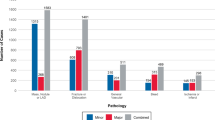Abstract
Purpose
Emergency radiology requires rapid and accurate interpretation of imaging examinations. Missed findings may lead to adverse outcomes. Double reporting may be used to minimize errors. Limited contemporaneous double reporting may be most efficient and cost-effective, but no data exists. This study is intended to examine the benefits of double reading and identify examinations where this would be most useful.
Methods
In this study, dual reporting was conducted in a parallel reading environment in a teleradiology practice for 3779 radiological procedures performed at two radiology centers in the USA over a period of 4 months. Discrepancies between reads were scored using the ACR peer review scoring system and grouped by modality and body part. Errors were tabulated across the study types, followed by identification of statistically significant differences. The interaction between image number and odds of an error was ascertained.
Results
In 145 instances (3.8%; 95 % CI, 3.2–4.4%), double reporting identified errors, leading to report modification. Study type was significantly related to error frequency (p = 0.0001), with higher than average frequencies of error seen for CT abdomen and pelvis and MRI head or spine, but lower than average for CT head, CT spine, and ultrasound. Image number was positively associated with error odds, but was not independently significant in a joint logistic regression model that included study type.
Conclusion
Dual reporting identifies missed findings in about 1 of 25 emergency studies. This benefit varies substantially across study types and limited double reporting, merits further investigation as a cost-effective practice improvement strategy.




Similar content being viewed by others
References
Baker SR (2003) Medical errors, quality, and safety: emergency radiology’s urgent matter. Emerg Radiol 10:69–70. doi:10.1007/s10140-003-0291-6
Briggs GM, Flynn PA, Worthington M, Rennie I, McKinstry CS (2008) The role of specialist neuroradiology second opinion reporting: is there added value? Clin Radiol 63:791–795. doi:10.1016/j.crad.2007.12.002
Fitzgerald R (2001) Error in radiology. Clin Radiol. doi:10.1053/crad.2001.0858
Murphy R, Slater A, Uberoi R, Bungay H, Ferrett C (2010) Reduction of perception error by double reporting of minimal preparation CT colon. Br J Radiol 83:331–335. doi:10.1259/bjr/65634575
Leslie A, Virjee JP (2002) Detection of colorectal carcinoma on double contrast barium enema when double reporting is routinely performed: an audit of current practice. Clin Radiol 57:184–187. doi:10.1053/crad.2001.0832
Liston JC, Dall BJG (2003) Can the NHS Breast Screening Programme afford not to double read screening mammograms? Clin Radiol 58:474–477. doi:10.1016/S0009-9260(03)00063-1
Markus JB, Somers S, O’Malley BP, Stevenson GW (1990) Double-contrast barium enema studies: effect of multiple reading on perception error. Radiology 175:155–156
Kalyanpur A, Weinberg J, Neklesa V, Brink JA, Forman HP (2003) Emergency radiology coverage: technical and clinical feasibility of an international teleradiology model. Emerg Radiol 10:115–118. doi:10.1007/s10140-003-0284-5
Wagner AL (2004) After-hours coverage: problems and solutions. J Am Coll Radiol 1:351–355. doi:10.1016/j.jacr.2004.01.018
Agrawal A, Agrawal A, Pandit M, Kalyanpur A (2011) Systematic survey of discrepancy rates in an international teleradiology service. Emerg Radiol 18:23–29. doi:10.1007/s10140-010-0899-2
Bradley WG (2004) Offshore teleradiology. JACR Journal of the American College of Radiology. doi:10.1016/j.jacr.2003.12.043
Kalyanpur A, Neklesa VP, Pham DT, Forman HP, Stein ST, Brink JA (2004) Implementation of an international teleradiology staffing model. Radiology 232:415–419. doi:10.1148/radiol.2322021555
Agrawal A, Kalyanpur A (2012) Synchronizing computer clocks: the challenge of multiple time zones in teleradiology. Indian J Radiol Imaging 22:240
Society of Nuclear Medicine and Molecular Imaging. Prevent cuts to medical imaging. Available at http://www.snmmi.org/files
Duszak R Jr. (2012) Medical imaging: is the growth boom over? Neiman report no. 1. Harvey L. Neiman Health Policy Institute website. www.acr.org/~/media/ACR/Documents/PDF/Research/Brief_01/PolicyBrief-HPI092012.pdf. Accessed 5 Aug 2013
Halsted MJ, Donnelly LF, Strife JL (2005) Radiologist recruitment and retention:how can we improve? J Am Coll Radiol 2(4):p369–p375
Arl VM, Allen B, Campbell SC, Carlson RA, Dunnick NR, Fletcher TB, Hanks JD, Hauser JB, Moorefield JM, Taxin RN, Thrall JH (2005) Report of the ACR task force on international teleradiology. J Am Coll Radiol 2:121–125. doi:10.1016/j.jacr.2004.08.003
Husby JA, Espeland A, Kalyanpur A, Brocker C, Haldorsen IS (2011) Double reading of radiological examinations in Norway. Acta Radiol 52:516–521. doi:10.1258/ar.2011.100347
Silva E, Breslau J, Barr RM, Liebscher LA, Bohl M, Hoffman T, Boland GWL, Sherry C, Kim W, Shah SS, Tilkin M (2013) ACR white paper on teleradiology practice: a report from the Task Force on Teleradiology Practice. Journal of the American College of Radiology: JACR 10:575–585. doi:10.1016/j.jacr.2013.03.018
Jackson VP, Cushing T, Abujudeh HH, Borgstede JP, Chin KW, Grimes CK, Larson DB, Larson PA, Pyatt RS, Thorwarth WT (2009) RADPEER scoring white paper. J Am Coll Radiol. doi:10.1016/j.jacr.2008.06.011
Johnson CD, Harmsen WS, Wilson LA, Maccarty RL, Welch TJ, Ilstrup DM, Ahlquist DA (2003) Prospective blinded evaluation of computed tomographic colonography for screen detection of colorectal polyps. Gastroenterology 125:311–319. doi:10.1016/S0016-5085(03)00894-1
Lian K, Bharatha A, Aviv RI, Symons SP (2011) Interpretation errors in CT angiography of the head and neck and the benefit of double reading. AJNR 32:2132–2135. doi:10.3174/ajnr.A2678
Borgstede JP, Lewis RS, Bhargavan M, Sunshine JH (2004) RADPEER quality assurance program: a multifacility study of interpretive disagreement rates. J Am Coll Radiol. doi:10.1016/S1546-1440(03)00002-4
Mucci B, Murray H, Downie A, Osborne K (2013) Interrater variation in scoring radiological discrepancies. Br J Radiol 86(1028). doi:10.1259/bjr.20130245
Roszler MH (1995) Radiology resident interpretationof emergency department radiographs. Emerg Radiol 2:45. doi:10.1007/BF02616389
Acknowledgments
We would like to express our sincere thanks to Mr. Ravikumar MN and the QA team of Teleradiology Solutions for their efforts towards archiving of data.
Author information
Authors and Affiliations
Corresponding author
Ethics declarations
Conflict of interest
The authors declare that they have no conflict of interest.
Sources of support
None.
Electronic supplementary material
Supplementary data 1
(PDF 79 kb)
Supplementary data 2
(PDF 82 kb)
Rights and permissions
About this article
Cite this article
Agrawal, A., Koundinya, D.B., Raju, J.S. et al. Utility of contemporaneous dual read in the setting of emergency teleradiology reporting. Emerg Radiol 24, 157–164 (2017). https://doi.org/10.1007/s10140-016-1465-3
Received:
Accepted:
Published:
Issue Date:
DOI: https://doi.org/10.1007/s10140-016-1465-3




